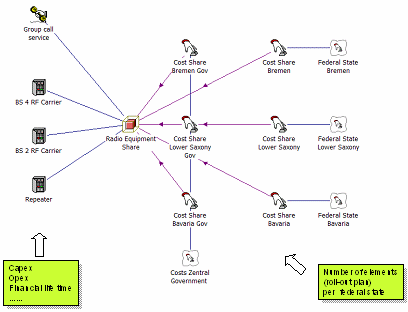 All
over Europe, a number of PMR (Professional Mobile Radio) networks are being installed.
These networks are often used by public safety authorities: the most recent example
is a PMR system in Germany for which the tender process is ongoing. However, PMR
systems are also used in industrial environments that have high requirements for
reliability and safety, for example, airports or the production facilities of car
manufacturing, chemical or power supply industries. DOK SYSTEME has carried out
STEM-based cost calculations on behalf of the German government for the public safety
network in Germany. This TETRA network will have more than 4000 base stations.
All
over Europe, a number of PMR (Professional Mobile Radio) networks are being installed.
These networks are often used by public safety authorities: the most recent example
is a PMR system in Germany for which the tender process is ongoing. However, PMR
systems are also used in industrial environments that have high requirements for
reliability and safety, for example, airports or the production facilities of car
manufacturing, chemical or power supply industries. DOK SYSTEME has carried out
STEM-based cost calculations on behalf of the German government for the public safety
network in Germany. This TETRA network will have more than 4000 base stations.
Choosing an appropriate technology
In the early stages of the German tender process, there was a big debate about whether
to choose a GSM-based proposal from Vodafone or a PMR solution. The mobile operator
wanted to offer a service based on its GSM network, extended by the GSM ASCI feature
set that had been developed for the European rail companies (ETCS). Vodafone got
as far as carrying out a field trail with the extended functionality designed to
meet the requirements of the public authorities.
At a certain point, however, the government changed its strategy and focused finally
on a PMR solution. Modern PMR systems are based on either the ETSI TETRA standard,
or the proprietary TETRAPOL system (EADS). These two digital trunked radio systems
are successors of the old analogue systems that have reached the end of their life
cycle. Currently we are seeing a big market boom in PMR all over Germany.
In September 2006, EADS finally won the contract with a TETRA system that had been
taken over from Nokia. The next steps will be the network roll-out and the procurement
of TETRA handsets.
Critical network dimensioning
The radio traffic design of trunked PMR networks is different from more familiar
radio networks such as GSM or UMTS, and a traffic-driven approach can’t be used
for a PMR STEM model. The main reason for this is that measurements of the traffic
on public safety networks such as those of police or fire brigade forces show no
typical traffic pattern over time, as is found on public telecoms networks. Thus
a typical main busy hour can’t be found. Therefore traffic engineering has to be
pre-planned and the dimensioning has to be done for critical events.
Splitting the costs using templates
As mentioned above, the network in Germany will have over 4000 base stations. The
cost will be split between the central government and 16 federal states. Thus the
STEM model had to do this cost split using STEM template elements in an intensive
way. Achieving this just by using Excel spreadsheets would have taken significantly
more time. The simplified example below illustrates the principle that was used.

Simplified example of cost split between geographical template elements
Using Excel for inputs and results
It has proved to be very helpful to use standardised Excel input matrixes for personnel
and infrastructure costs. Using this approach for cost-driven models, even big STEM
models can be built in a short period of time. Another advantage is that these input
matrixes can be readily discussed with people who are not familiar with STEM, for
example with clients during project meetings.
Also very useful was the use of the Excel STEM add-in to import results into a spreadsheet.
Cash flow and P&L computations for all the German stakeholders became very simple
by using a standardised naming convention for the resource elements. (Due to differences
in German commercial and public law, some changes had to be made in the P&L
tables compared to the original STEM results sheets.)
Wider applications
The model discussed here was for a large-scale, national roll-out. Nevertheless,
a STEM-based PMR model could be easily scaled down to smaller TETRA networks.
A similar methodology could also be used for other radio technologies, and the dimensioning
elements in STEM are flexible enough to allow the modeller to choose between the
‘critical network dimensioning’ described here, and the more typical busy-hour approach
used for dimensioning carrier networks.
 Dr.-Ing. Jan Steuer is a Managing Partner at DOK SYSTEME since 2003. Previously
he worked with Siemens’ Carrier and Enterprise Division in the UK. Jan received
his doctorate in the area of radio communications from the University of Hanover,
Institute for Communications, where he worked as a research assistant for several
years and published several papers, and currently lectures on UMTS.
Dr.-Ing. Jan Steuer is a Managing Partner at DOK SYSTEME since 2003. Previously
he worked with Siemens’ Carrier and Enterprise Division in the UK. Jan received
his doctorate in the area of radio communications from the University of Hanover,
Institute for Communications, where he worked as a research assistant for several
years and published several papers, and currently lectures on UMTS.
DOK SYSTEME GmbH is a small German consulting
company with 30 employees, specialising in ITC business and technology consulting.